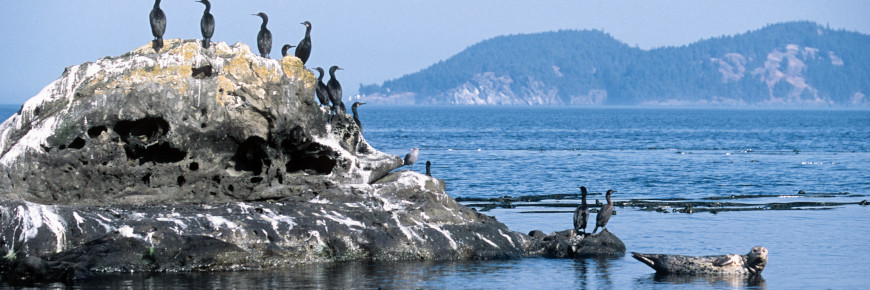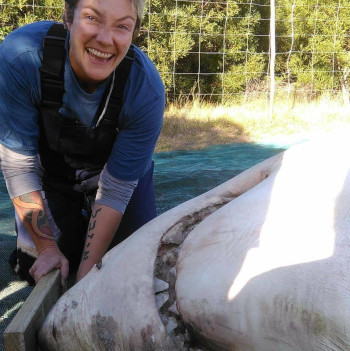
A shark-filled life
It’s been a long voyage of discovery for Parks Canada scientist Meaghen McCord, who brings an international perspective to her work as Marine Ecologist Team Lead at Gulf Islands National Park Reserve in British Columbia.
Sharks first swam into Meaghen McCord’s imagination when she was growing up in a small landlocked hamlet south of Ottawa.
“My dad was quite the hippie,” she says. “We lived in the bush and had no electricity.” But she had nature at her doorstep, and plenty of books to kindle her dreams.
“From an early age,” she says, “my one and only goal was to study sharks, whatever type or size.”
From tiny Mountain, Ontario—which had no ocean any more than it had a mountain—Ms. McCord eventually moved to Halifax to do an undergraduate degree in marine biology at Dalhousie University.
Then it was on to South Africa, where she got a master’s degree in fisheries science from Rhodes University.
“I have a driving need to challenge myself and step outside my comfort zone,” she says.
Most people would not budge from their comfort zone if they saw sharks swimming around outside it. For Ms. McCord, this is an invitation.
While in South Africa, she founded the South African Shark Conservancy as well as an ecotourism venture called the Shark Company, to raise funding and awareness for shark conservation.
Then, after seventeen years in South Africa, Ms. McCord relocated with her family back to Canada. Since January 2020, she has been Marine Ecologist Team Lead at Gulf Islands National Park Reserve in British Columbia.

It’s a job for a conservation generalist like Ms. McCord, who ranged widely in her South African work, from outreach to partnership creation to data collection.
An important part of her job at Gulf Islands is doing species surveys. Staff count and classify young fish in eelgrass beds and clams in intertidal zones. They record birdsong in the forests and survey a species of shorebird called black oystercatchers.
These surveys essentially allow staff to take the ecological pulse of the park reserve. Together they give a picture of ecosystem integrity —the wholeness and health of the protected area.
A waystation for wild travellers
Gulf Islands National Park Reserve is the ideal workplace for someone like Ms. McCord, who has circled the globe to pursue marine conservation. It’s fairly small—15 islands and 36 square kilometres. But in a way, it contains entire ocean basins and continents.
Some of the marine mammals you might glimpse in or around the park reserve, including leatherback turtles and humpback whales, can come from as far away as Malaysia and Hawaii. Even the area’s famous visitors, the Southern Resident Killer Whales, are not so resident. They can range as far south as central California.

For many bird species, the park reserve is a stop on an intercontinental migratory route, the Pacific Flyway.
The Gulf Islands are really a kind of a waystation for wild travellers. And protecting these travellers depends on more than the park reserve itself.
Southwestern British Columbia (including the Gulf Islands) is identified as one of eleven “priority places” by the Pan-Canadian Approach to Transforming Species at Risk Conservation in Canada. These priority places all have high concentrations of species at risk as well as well as significant opportunities to advance conservation.
The Pan-Canadian approach tackles whole ecosystems, not just places. It casts its net beyond protected areas to include the landscapes (and seascapes) that contain them. And it requires strong partnerships among governments, Indigenous peoples, private companies and non-governmental organizations.

This kind of big-horizon conservation fits in very well with Ms. McCord’s approach in South Africa, where she combined science, mentorship and community outreach. One technique she used in South Africa, and is keen to try here, is called BRUV (Baited Remote Underwater Video).
“It basically involves putting a camera and a bait canister into the ocean,” she says, “where it sinks to the seafloor and remotely monitors marine life. It’s easy to use, non-invasive and attracts shy creatures.”
She worked with WWF South Africa and marginalized coastal fishing communities to use BRUV to monitor the effectiveness of marine protected areas near Cape Town, South Africa. Fishers and communities alike were provided with training to eventually lead the project, creating a sense of stewardship for threatened marine resources.
And what sharks might show up in a BRUV at Gulf Islands?
Probably the most likely one is the Pacific spiny dogfish, a small shark named for its venomous spines.
But about sixteen shark species can be seen in British Columbia waters, including the six-gilled shark, the basking shark and (rarely) that famous film icon, the great white.
Sharks have always inspired fear (not to mention over-the-top movies), but as the oceanographer Sylvia Earle put it, “you should be afraid if you’re in the ocean and you don’t see sharks.” Like killer whales, sharks are a barometer of healthy seas.

“Sharks are facing the same issues that killer whales are facing, like pollution and habitat destruction,” says Ms. McCord. For her, shark conservation is ocean conservation, because of the interconnectedness of the marine environment.
"How inappropriate to call this planet Earth when it is clearly Ocean," remarked the science fiction writer Arthur C. Clarke. From her vantage point at Gulf Islands, Meaghen McCord is working to protect planet Ocean while “sharing sharks with the world.”
- Date modified :